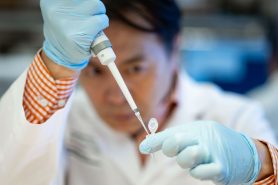Our Methods
We use the following methods in our lab:
MCL models:
Cell lines and cell line-derived xenografts. There are many human MCL cell lines available for study, and we are adept at making modified cell lines. For example, we can establish drug-resistant cell lines through culturing with very gradual increases in drug concentration, and we knock in and knock out key genes using CRISPR/Cas9 genome editing. We use these cell lines not only for in vitro studies but also, by implanting them in immunodeficient mice, for in vivo studies as cell-line derived xenografts (CDXs). These xenografts develop following the injection of human MCL cells into the subcutaneous space or the tail vein of immunodeficient NSG mice.
Patient-derived xenografts. In addition, my laboratory here was the first to establish an MCL patient-derived xenograft (PDX) mouse model for the preclinical study of MCL and other B-cell lymphomas (Zhang et al., Clinical Cancer Research, 2017), which was instrumental to studies of MCL. The PDXs are xenografted in the same locations as the CDXs. Most importantly, they maintain the same biological, histopathologic and immunophenotypical features of the original patient tumors, with similar genetic mutations and comparable drug responses. We have successfully used these models to test novel therapies for the treatment of MCL. We use these PDXs extensively to predict and personalize therapies and address therapeutic resistance in MCL and other B-cell lymphomas.
Organoids. We have also created a protocol for establishing organoid cultures from MCL patient biopsies. The organoids reproduce primary tumor- and patient-specific characteristics including phenotypic properties and genomic aberrations and exhibit patient-dependent responsiveness to drugs. Moreover, they are quick and cost-effective MCL models with a high rate of successful establishment, and they serve as invaluable platforms for efficacy testing and mechanistic studies.
Testing treatment efficacy. We commonly use PDXs and patient-derived organoids (PDOs) from patients with acquired or intrinsic resistance to one or more treatments to assess the efficacy of new treatments. Efficacy is assessed by tumor size and overall survival; toxicity is assessed by decreased motor activity, loss of body mass, dehydration, failure to groom and so on. Additionally, mice are euthanized at study endpoints, and selected organs are harvested and histologically assessed. Tumors are then analyzed by immunoblot and qRT-PCR for changes in expression of proteins of interest. In PDOs, efficacy is assessed by 3D cell viability assay.
Transcriptome profiling. Samples are collected before treatment and after treatment if the patients relapse from or are refractory to treatment. We use bulk RNA sequencing of patient samples to understand the transcriptomic reprogramming responsible for therapy resistance. Alternatively, we use the scRNA-seq approach to sequence thousands of cells per sample, then perform in-depth bioinformatics analysis on the scRNA-seq data. Unsupervised uniform manifold approximation and projection is then used to map cell cluster distributions and identify distinct transcriptome profiles within the same cell type across patient outcomes. Individual clusters associated with treatment sensitivity, intrinsic resistance and acquired resistance (relapse) are identified for outcome-associated differentially expressed genes and pathways. The high resolution of this approach allows us to map cell clusters and their transcriptome profiles among not only cancer cells but also cells of the tumor microenvironment, including CD4+ and CD8+ T cells, NK cells, myeloid cells and their derived subsets (e.g., exhausted T cells), to determine their association with resistance.
Pseudo-temporal analysis. Beyond this, we implement pseudo-temporal analysis to reveal the continuous trajectory for evolution of drug resistance. Briefly, single cells are ordered along deterministic or probabilistic trajectories and a numeric value referred to as pseudo-time is assigned to each cell to indicate how far it progresses along a dynamic process of resistance evolution. We perform pseudotemporal ordering using Monocle 3 analyses to reconstruct the resistance dynamics among pre-therapy-sensitive, pre-therapy-resistant (refractory) and post-therapy-relapsed samples. We determine whether these are distinct states in a loosely connected trajectory or whether they form a continuum with sensitive and relapsed states at two ends of the spectrum. By focusing on scRNA-seq data, a graph trajectory through the respective clusters in UMAP space can be generated.



